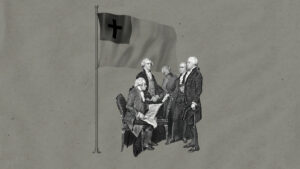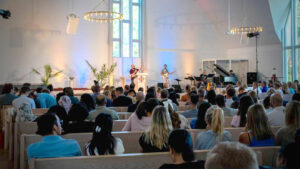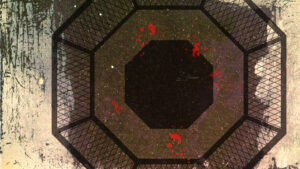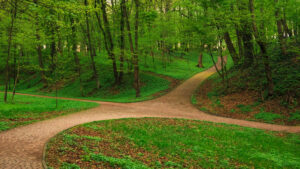“All waves speak, but they speak in tongues, and we can’t interpret their speech. That’s probably because it’s too simple, like God’s. Maybe all they’re saying is I LOVE YOU, I LOVE YOU, I LOVE YOU, I LOVE YOU, I LOVE YOU until the end of time. Like God . . . .” — Peter Kreeft
I’m writing from a hotel next to the Pacific Ocean. The view is spectacular, and I can’t stop looking at (and listening to) the dynamic coastline, where the liquid vast blue sea meets the solid vast brownish land. The intersection is vivid white, an always changing line of waves breaking unpredictably against the steady shoreline.
There are crowds on the beach, swimming and surfing and simply watching the waves. Cheerful shouts of families fill the salty air. This scene happens on almost every coast, every day, around the world. Why?
“The coast is beautiful” is something existentially true and intuitively felt among humans. We’re drawn to places where land meets sea, where water meets rock; two very different things coming together to produce an aesthetic pleasure and a life-giving good.
Natural Complementarity
We’re attracted to this familiar cosmic reality. We find comfort and resonance in the complementarity of nature, because this is how humans are wired too. Men and women are beautifully different but made for each other. Just as there’s beauty and life where water and rock come together, so is there beauty and life where woman and man come together.
This truth is profoundly articulated in the Vatican’s excellent Humanum video series, particularly in episode 3, “Understanding Man and Woman.” In this beautifully made, 17-minute video, philosopher Peter Kreeft discusses the intersection of rock (“one of the most masculine things in the world”) and sea (“one of the most feminine things in the world”):
They’re deeply satisfying together, and we can’t quite analyze why we find that satisfaction and that peace and that sense of rightness. . . . The shore is the most popular place on earth. Waterfront property is the most expensive property anywhere in the world. Because that’s where the sea and the land meet. That’s where man and woman meet. The land without the sea is kind of boring, desert. The sea without the land is kind of boring. When are we going to land the ship? But the place where they meet, that’s where all the action is. And that’s where we want to be.
I think Kreeft is on to something. Humans don’t have to be told that male and female are different and made to go together. This truth is self-evident, declared in basic elements of the natural world: water and land.
Beautiful Complementarity
We’re attracted to these elements because water and rock together are nature’s most beautiful artistic pairing. Water can erode and mold and smooth rock. Rock can guide and contain and filter water. Their wrestling is necessary and good, and it creates beauty. What is the Grand Canyon? Rock carved by water. What are waterfalls? Water traversing rock. Whether glaciers or cascades, snow-capped mountains or geysers, the places where water and rock meet are where painters, photographers, tourists, and lovers flock.
Certainly there’s also beauty in the sea alone and in the land alone. We can gaze into the ocean and marvel at its power and depths, or ponder a vast desert and see its innate beauty. But where the two come together, as Kreeft says, “that’s where all the action is.”
So we flock to Big Sur, Pebble Beach, the French Riviera, the fjords of Norway, the Great Lakes, Iguazu Falls, the Florida Everglades, Cape Cod, the Snake River. Throngs are converging on Yosemite National Park this summer since record snowfall in the Sierras means the park’s waterfalls are unusually spectacular. Humans of all walks of life recognize the beauty of mountain water rushing over steep granite cliffs. Water and rock.
Life-Giving Complementarity
But aesthetics isn’t the only reason we gravitate toward two complementary things coming together. We can’t live without these elements; they’re fundamental ingredients of life. We need foundations upon which to build our homes, but we also need sources of water. Cities spring up where land and water meet, on the banks of rivers and lakes and oceans.
Water and land combine and, with the help of sun and seed, create life. Dirt plus dirt can’t bring a seed to life. Water plus water can’t do it. But together they create conditions for new life to flourish.
There are many confusing ideologies about gender being propagated today, including the notions that men and women are indistinguishable and interchangeable, and that gender difference is nothing more than a cultural construct.
But on the biological level alone, male is no more interchangeable with female than water is interchangeable with rock or night interchangeable with day. Try as we might, humans will never be able to create new life without male plus female, just as a field of seeds will never sprout if only dust, not water, falls on the ground.
The complementarity of gender isn’t a menace or construct, but—like coastlines and lakefronts and river trails we love—an irresistible source of beauty and life.
Editors’ note: A version of this article appeared at brettmccracken.com.
Download your free Christmas playlist by TGC editor Brett McCracken!
 It’s that time of year, when the world falls in love—with Christmas music! If you’re ready to immerse yourself in the sounds of the season, we’ve got a brand-new playlist for you. The Gospel Coalition’s free 2025 Christmas playlist is full of joyful, festive, and nostalgic songs to help you celebrate the sweetness of this sacred season.
It’s that time of year, when the world falls in love—with Christmas music! If you’re ready to immerse yourself in the sounds of the season, we’ve got a brand-new playlist for you. The Gospel Coalition’s free 2025 Christmas playlist is full of joyful, festive, and nostalgic songs to help you celebrate the sweetness of this sacred season.
The 75 songs on this playlist are all recordings from at least 20 years ago—most of them from further back in the 1950s and 1960s. Each song has been thoughtfully selected by TGC Arts & Culture Editor Brett McCracken to cultivate a fun but meaningful mix of vintage Christmas vibes.
To start listening to this free resource, simply click below to receive your link to the private playlist on Spotify or Apple Music.


































